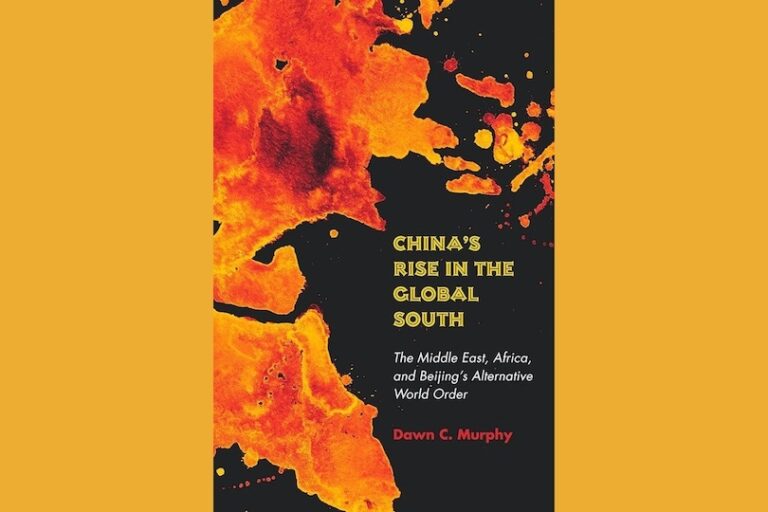China’s Rise in the Global South: The Middle East, Africa, and Beijing’s Alternative World Order
By Dawn C. Murphy
Stanford University Press, 2022
Geopolitical tension between the United States and China is often placed in the context of rivalry in the Pacific region. Dawn Murphy contributes to this conversation with refreshing analysis focusing on China’s efforts in Africa and the Middle East. In these regions, she convincingly argues, China is establishing spheres of influence and is increasingly competitive with the United States and the West, challenging the rules of the liberal international order. (p. 8). Beijing’s goal is to build an alternative order that can one day supplant the United States as the preeminent power. Murphy offers a useful framework that conceptualizes China’s efforts into categories of cooperative or competitive political, economic, and military actions relative to U.S. efforts, and determines whether those efforts converge or deviate from the norms of the liberal international order (p. 9).
In The rise of China in the Global SouthMurphy sheds light on a topic that is increasingly relevant and discussed in academia and policy circles. Rushing Doshi And Ketian Zhang draw similar attention to China’s efforts and global ambition. While Doshi offers a broad perspective of China’s ambitions and Zhang provides a refined understanding of a specific foreign policy tool, Murphy’s contributions to this discussion provide a middle-ground comparative aspect of China’s foreign policy efforts in two important regions, Africa and the Middle East. East.
Murphy’s book is an excellent introduction to understanding China’s vast political, economic, and military efforts in two regions of interest. Each topic could constitute a book in itself, but the numerous but substantial research questions Murphy explores provide an appreciation of complex topics in a simple but informative style for the reader. Each chapter is easy to digest and covers the main themes of his research for each region of interest. Murphy frames the comparison by assessing the geopolitical competition between China and the United States in each region. The Middle East is of course a region of mutual strategic interest for China and the United States; while Africa is a region that interests China, but is not often a policy priority for the United States. His portrait provides nuances for understanding the actions of Beijing, which avoids the term revisionism which is often overused in political analyses. Rather, his works show a gradual shift over time, focusing on a significant period of China’s development and influence, from 1991 to 2019.
An analysis of two regions requires a lot of time and financial resources, which is often not possible for researchers. Thus, Murphy’s lack of fieldwork in Africa is clearly evident as he was limited to South Africa alone. To be fair, South Africa’s strategic relationship with China, which has deep historical, political and economic ties, is worth investigating if a country is to be chosen. While more fieldwork is often beneficial, it compensates for these constraints with interviews and analysis of official documents. His use of Chinese primary sources to amplify his narrative is particularly beneficial. Although much of his work is qualitative, it would have been easy and useful to incorporate a multi-method approach to his research. For example, Murphy provides figures on China’s arms sales to countries, but other than providing total values for time periods, there is no analysis to highlight useful trends (p. 227) . Arms transfers are a particularly important foreign policy tool, largely because Beijing does not impose conditions on arms transfers as do many Western states. Furthermore, it would have been beneficial to revisit the subject of sovereign debt. China’s Belt and Road Initiative is an important policy tool that burdens states with significant debt, but the effects of this concern are not adequately discussed. Much ink has been spilled in the debate over “debt trap diplomacy” and it largely avoids that debate.
One of the conclusions of this book is that China’s foreign policy efforts are characterized as competitive in its economic and political actions in the Middle East and Africa, while Beijing’s military efforts are largely cooperative. At the risk of painting a darker picture, it perhaps exaggerates the cooperative aspect of Chinese military efforts. Murphy highlights two military efforts: UN peacekeeping operations and China’s support for anti-piracy operations. A closer look at China’s incentives and participation in these efforts shows that Beijing’s actions are in fact less cooperative and more competitive than claimed. For example, China’s anti-piracy operations in the Red Sea and Gulf of Aden were not part of multinational efforts in the region; China instead chose to operate independently (p. 229). More telling is China’s support for UN peacekeeping efforts. that of Beijing Science of military strategy (2020), an official military strategy and planning document, specifies two notable objectives of China’s participation in UN peacekeeping missions. One of them is to improve bilateral relations with the country in which the troops are deployed, and another goal is to create good overseas investment for the future. In the government’s own words, Beijing sees the use of UN troops as a way to improve bilateral relations and strengthen interests. As Murphy points out, China’s deployment sites at the UN reflect concern about the potential impact on its own economic security (p. 221). Given the above considerations, one can rightly interpret China’s military actions as competitive rather than cooperative, as Murphy argues.
Despite the gaps in assessing China’s military efforts, Murphy’s work constitutes an important and refreshing contribution to the literature describing China’s global ambitions in two geopolitically sensitive regions. By avoiding common peaceful and Eurocentric approaches to studying the competitive rivalry between China and the United States, its contribution to The rise of China in the countries of the South fills a gap in the existing literature. Furthermore, this book will be useful for policymakers and academics to understand the context in which this rivalry will occupy their work for the foreseeable future.
Further reading on international electronic relations


